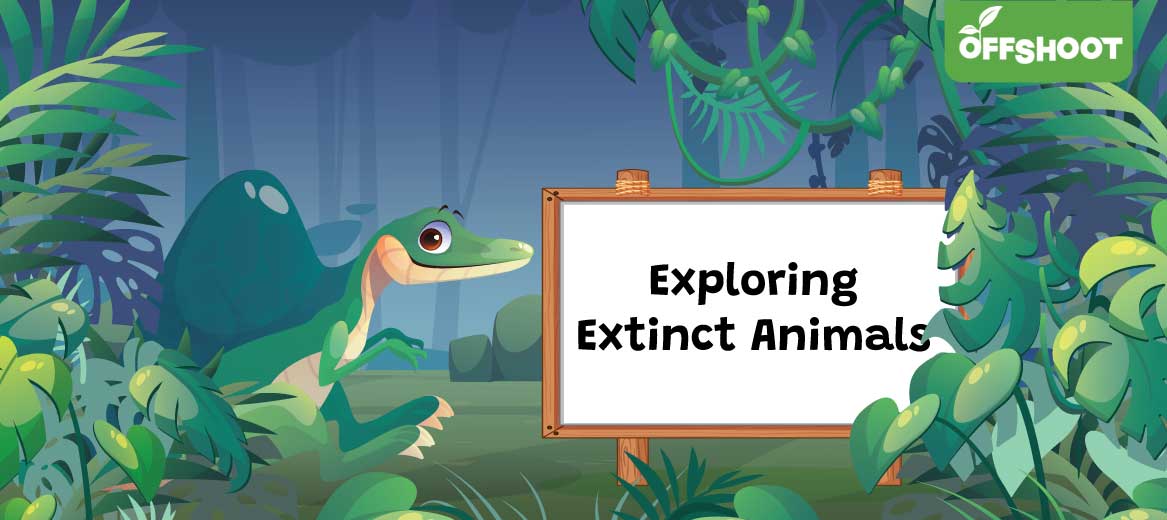
Exploring the World of Extinct Animals Through Pictures
| Offshoot Books
Exploring Extinct Animals
There are some animals that no longer exist on Earth. They have completely disappeared from the wild, and there are no living animals of their kind. Such animals are categorised as “extinct animals”. Being “extinct” means “no longer existing”. Once a species is classified as extinct, it means there are no surviving members of that species anywhere in the world. A number of reasons are responsible for the extinction of animals. These include environmental changes, habitat loss, climate shifts, natural disasters, and human activities such as hunting, pollution, and deforestation.
Learning about extinct animals is like going on an adventure across ages! Imagine meeting incredible creatures that once roamed the Earth but are no longer to be seen. To become your companion in this adventure, Offshoot Books has come up with “The Extinct Book”. This book is an illustrated repository of information about extinct animals.
It has illustrations of various extinct animals, their scientific names, information about their habitat, eating habits and reasons for extinction. Knowing about extinct animals helps us appreciate the incredible variety of life that existed before us and teaches us how important it is to take care of the animals we have today. So, let's put on our explorer hats and dive into the blog to know about a few extinct animals.
Extinct Animals:
Dodo

Source: The Extinct Book/Offshoot Books
Scientific Name: Raphus cucullatus
Last Seen: 1681
Lived In: Forests
Found In: The island of Mauritius in the Indian Ocean
Steller's Sea Cow

Scientific Name: Hydrodamalis gigas
Last Seen: 1768
Lived In: cold water
Found In: Before the ice Age, it lived everywhere from Japan to Baja Peninsula. By the 18th century, it survived only in Arctic islands between the Aleutians and the Kamchatka Peninsula
Irish Elk

Source: The Extinct Book/Offshoot Books
Scientific Name: Megaloceros giganteus
Last Seen: 11,000 years ago
Lived In: Open Grasslands
Found In: Ireland, Great Britain, China and Siberia, northern Africa
Carolina Parakeet

Source: The Extinct Book/Offshoot Books
Scientific Name: Conuropsis carolinensis
Last Seen: 1939
Lived In: forest along rivers
Found In: Southern New York and Wisconsin to the Gulf of Mexico, Tennessee, Kentucky and the western part of the Mississippi River
Giant Ground Sloth

Source: The Extinct Book/Offshoot Books
Scientific Name: Megatherium
Last Seen: 11,700 years ago
Lived In: Woodlands, grasslands.
Found In: native to South America; briefly appeared in North America too
Golden Toad

Source: The Extinct Book/Offshoot Books
Scientific Name: Incilius periglenes
Last Seen: 1989
Lived In: Welfin forest—rare forests with miniature trees and plants which inhabit small species of reptiles and rodents
Found In: was native to and only found in Monteverde, Costa Rica
Helicoprion

Source: The Extinct Book/Offshoot Books
Scientific Name: Helicoprion bessonow
Last Seen: approx. 270 million years ago
Lived In: Oceans and seas
Found In: North America, eastern Europe, Asia and Australia
Woolly Mammoth

Source: The Extinct Book/Offshoot Books
Scientific Name: Mammuthus primigenius
Last Seen: 5,600 years ago
Lived In: tundra, grasslands, ice sheets
Found In: South America, Australia and Antarctica
We often talk about animals and plants being in danger, like being 'Endangered' or 'Vulnerable.' But what do these terms really mean? Well, a number of organisms around us are facing threats like climate change, hunting, loss of habitat and lack of food.
To help us understand the condition of different species, an organisation called IUCN has come up with a list, it is called IUCN Red List of Threatened Species or Red List. So, how does this Red List work? After a detailed study of the living conditions of different species, they are put under different categories in the Red List.
Check out the definitions of different categories below.
Least Concern
Widespread and not under the threat of any incoming danger. For example, macaw.
Near Threatened
A species is facing some dangers and could in the near future be placed in a ‘threatened’ category. For example, jaguar.
Vulnerable
Facing a high risk of extinction in the wild. For example, giant pandas.
Endangered
A species that’s facing a serious risk of extinction in the wild. For example, Asian Elephants.
Critically Endangered
Facing an extremely serious risk of extinction in the wild. For example, Black Rhino.
Extinct In The Wild
A species no longer found in the wild, but a few individuals are only found in zoos, botanical gardens or breeding programmes. For example, Butterfly Splitfin.
extinct
No individuals exist in the wild, in captivity or cultivation. For example, dodo. Read about other extinct animals from “The Extinct Book” and write other examples.
Many animals are at risk of extinction, and when a species' population declines, it endangers the entire world by disturbing the balance of nature. Saving animals is important because we share this world, and together, we create a vibrant and joyful environment. Preserving their habitats ensures a harmonious and colourful planet for all of us.
Read More.
Where Can We Find the Top 10 Endangered Animals with Endangered Animals Chart?

Leave a comment
Your email address will not be published.